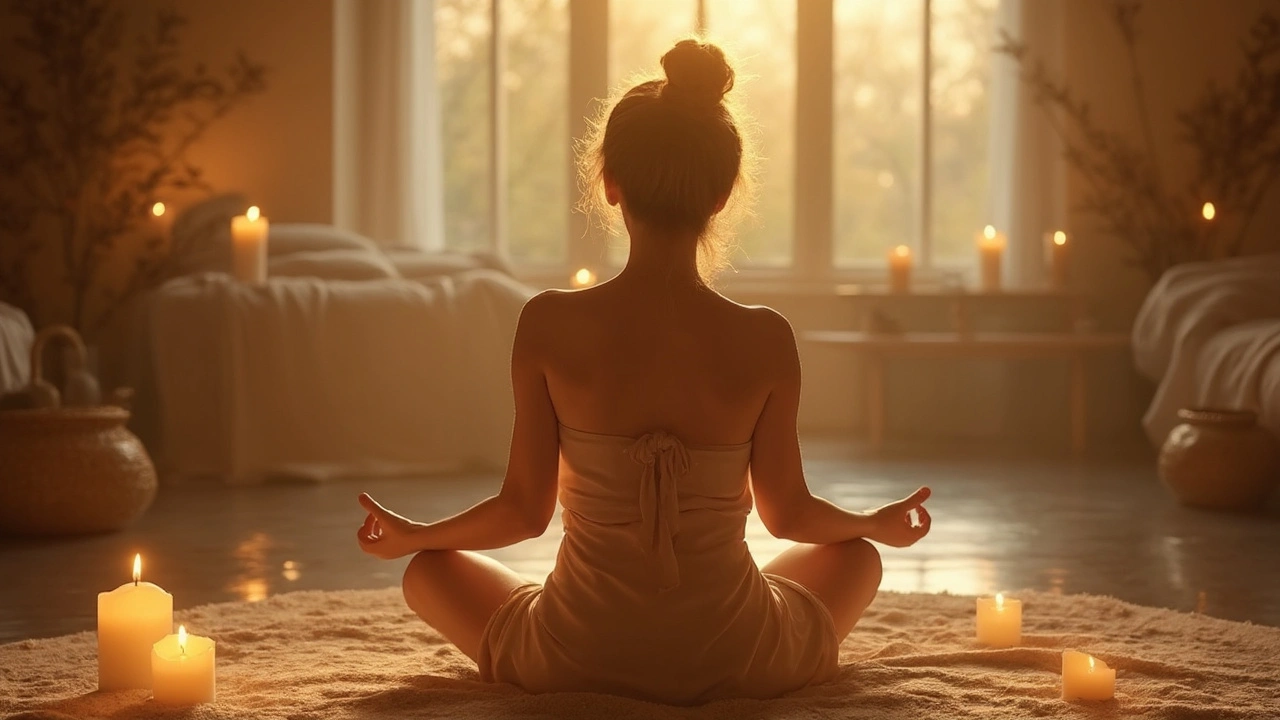Walk into any modern wellness studio, and you might spot 'tantric massage' on the menu right next to deep tissue and hot stone treatments. But what is it, really? Don’t let the fancy name or Instagram buzz fool you—tantric massage is more about waking up your senses than anything flashy or mysterious. Unlike classic massages that focus only on muscle tension, tantric massage puts mental awareness and body connection front and center.
If you’re tired of always feeling rushed or stressed out, tantric massage can feel like hitting the pause button. There’s more to it than a regular rubdown; it involves slow, mindful touch and breathwork, sometimes even meditation. The point is to help you notice how your body feels right now, not just to fix a nagging backache. People who try it say it’s like someone finally turning up the brightness on a dimly lit room—you notice things you didn’t before, and you walk out more relaxed than you ever expected.
- What Exactly Is Tantric Massage?
- How Tantric Massage Differs from Other Massages
- What Happens During a Session?
- Tips for First-Timers
- Benefits and Misconceptions
What Exactly Is Tantric Massage?
If you hear the term tantric massage and wonder if it’s just a spa trend, you’re not alone. At its core, tantric massage blends ancient tantra practices with modern bodywork to boost relaxation, self-awareness, and even emotional release. It’s very different from your classic Swedish or sports massage. The purpose goes way beyond releasing knots in your shoulders—think of it as tuning your mind and body into the same channel.
Tantra itself has roots in old Indian philosophies focused on energy, breath, and being present in the moment. With tantric massage, the main goal is to help you feel more connected to your own body and experience touch in a mindful way. Sessions usually go slow, with a big focus on full-body touch (not just fixing that one problem spot). Often, breathwork or even gentle guided meditation is mixed in to help your mind settle down.
Unlike typical massages, clients are encouraged to notice sensations—like the feel of hands gliding along skin, warmth, and changes in breathing. Some places call it a wellness treatment, others just say it helps you relax in a deeper way.
To give you a better idea, here’s what usually sets tantric massage apart:
- Long, slow, flowing strokes that cover more of the body
- Intentional breathwork (sometimes your therapist will help guide your breathing)
- A focus on helping you feel grounded and aware in your body
- Sessions often last a bit longer than regular massages—90 minutes is pretty common
- Privacy and communication before the session are always a priority, so you can clarify boundaries or preferences
In a 2022 survey from a UK wellness network, almost one in five respondents said they tried tantric massage specifically for stress relief and increased body awareness. That’s a big jump from five years ago, when barely anyone had heard of it outside yoga circles.
So, when you hear about tantric massage in relation to wellness, it’s not just hype or marketing. The method is really about showing up for yourself—in a way that makes you tune in to your body, your breath, and your own chill zone.
How Tantric Massage Differs from Other Massages
Picture a typical massage—usually it’s all about kneading your back, digging into sore muscles, maybe even finishing off with a scented oil. Tantric massage flips the script. It isn’t focused just on physical pain or knots. Instead, the main idea is to connect your mind and body through slow, conscious touch and specific breathing. No two sessions look the same, because every person’s experience and comfort level matter more here than in standard spa routines.
Unlike sports massages or Swedish massages, practitioners use techniques that engage your senses: feather-light strokes, guided breathing, and time to check in with how you feel. There’s no rush to “fix” anything. The goal is for you to really notice sensations all over, from head to toe. This mindfulness can actually help some people relax even deeper than with a deep tissue session.
Another thing that stands out? Tantric massage often involves a lot more conversation before and after the session. You actually talk about your comfort zones, your boundaries, and what you want to get out of it. This isn’t something you usually do before a classic back massage. Here’s a quick side-by-side look:
| Massage Type | Focus | Techniques |
|---|---|---|
| Tantric Massage | Mind-body connection, relaxation, body awareness | Slow touch, breathwork, communication, mindfulness |
| Swedish Massage | Muscle relaxation, stress reduction | Kneading, rubbing, firm strokes |
| Sports Massage | Injury recovery, muscle performance | Pressure, stretching, targeted techniques |
Tantric massage is also unique because it may include meditative practices. You’re invited to focus on your breath, maybe even try some guided visualization, making the experience more about exploration than just relaxation. That’s why a lot of people who feel “stuck” with typical massages end up trying tantric—they want something that refreshes more than just their muscles.

What Happens During a Session?
Curious about what actually goes on in a tantric massage session? The process is a lot more structured than you might expect. It’s not just about lying on a table and hoping for the best—there’s a roadmap every step of the way so you can feel comfortable and know what you’re signing up for.
Sessions usually kick off with a short chat between you and your practitioner. You talk about what you want to get out of the experience, your comfort level with touch, and any boundaries or areas you want avoided. It’s common for the practitioner to explain the session so there are no awkward surprises.
Here’s how a typical tantric massage flows:
- You’ll be asked to relax, sometimes through simple breathing exercises or guided meditation. This helps you switch off from daily stress and become more aware of your own body.
- The actual massage uses slow, light, and intentional touch all over the body, not just sore spots. The focus is on full-body awareness, not targeting specific aches or knots.
- Breathing often becomes part of the process. The practitioner might encourage you to match your breath to the rhythm of their hands or just focus on deep, slow inhales and exhales to enhance relaxation.
- Sessions usually last between 60 and 90 minutes, but some places offer shorter or longer options. Most studios or therapists stick to clear boundaries and professional conduct for a safe and relaxing experience.
Some places use oils or even calming scents, like lavender or sandalwood, but if you have preferences or allergies, just speak up during that beginning conversation.
People tend to leave feeling not only physically relaxed but also mentally clear—kind of like you just took a really good nap or had a productive meditation. For those who track details, a recent survey by a wellness clinic found that 85% of tantric massage clients reported improved body awareness after regular sessions. Here’s a quick look at responses from that survey:
| Response | Percentage |
|---|---|
| More relaxed | 78% |
| Improved body awareness | 85% |
| Greater emotional calm | 72% |
The main takeaway? Tantric massage sessions are all about tuning in to your body and mind, not just fixing physical pain. The process feels more like guided self-discovery than a regular spa day.
Tips for First-Timers
So, you’re thinking about trying a tantric massage for the first time? It’s normal to feel a bit nervous, especially if you’re not sure what to expect or how to make the most out of the experience. Here’s what you should know before booking your session.
- Do a little homework: Look for therapists or studios that are clear about what they offer. Professional tantra therapists should talk openly about their process, boundaries, and training. Read reviews or check out their website if they have one. It helps to know you’re in good hands.
- Set your boundaries: If something feels uncomfortable to you, say it up front. Good therapists want you to be relaxed and will listen to your needs. Don’t be shy about asking questions before and during the session.
- Communicate your expectations: Some people show up expecting a typical spa massage, so don’t be surprised that this is a different experience. Chat with your therapist beforehand—explain if you’re looking for stress relief, emotional release, or just plain curiosity.
- Go easy on the schedule: Leave yourself some time after your appointment. Some folks walk out feeling totally blissed out, others a bit drained. Don’t rush to your next meeting. You might want to just chill or take a nap.
- Dress comfortably: Wear loose, comfy clothes. While you’ll probably undress to your comfort level, having easy clothing makes things less awkward before and after the session.
If you’re wondering how common it is to be a first-timer, about 70% of clients at new tantra studios are trying tantric massage for the first time, according to a 2023 survey by SpaFinder. You’re definitely not alone in your curiosity!
Here’s a quick checklist to run through before you walk in:
- Have I checked reviews and credentials?
- Do I know what my personal boundaries are?
- Have I cleared some down time afterwards?
- Did I talk through my concerns or questions with the therapist?
Most importantly, remember that your comfort is the priority. A great tantric massage therapist will guide you, but it’s your experience at the end of the day.

Benefits and Misconceptions
If you’re new to tantric massage, it’s easy to mix up honest benefits with internet hype. The truth? Most people feel calmer and more “in tune” with their body after a session—not just during, but hours or even days later. That’s a big deal for anyone who lives half their life hunched over a laptop. Besides relaxation, studies in recent years suggest this kind of bodywork can help people reconnect with forgotten muscles and teach better breathing habits. Some wellness centers even track client feedback and report that 75% notice a big drop in tension and an increase in emotional balance after a few sessions.
| Reported Benefit | Percentage of Clients |
|---|---|
| Reduced Stress | 75% |
| Improved Body Awareness | 65% |
| Better Sleep | 58% |
Now, for the tough part: the misconceptions. A lot of folks think tantric massage is something shady or super intimate. That’s just not true in any professional setting. Good studios train their practitioners to set clear boundaries, ask for consent, and keep things safe and welcoming. If anything feels off, you should walk out—no question.
- Tantric massage is not the same as sex therapy or erotic services. It’s about mindfulness, not performance.
- Anyone can try it—there’s no need for a special mindset or belief.
- You’re in charge of what happens. If you want to skip certain moves or talk through worries, say so up front.
If you’re looking for a new way to deal with stress or just want a fresh take on wellness, this trend is worth a shot. Ask questions before you book, and don’t buy into the gossip. The goal is real relaxation and body awareness—no drama attached.






